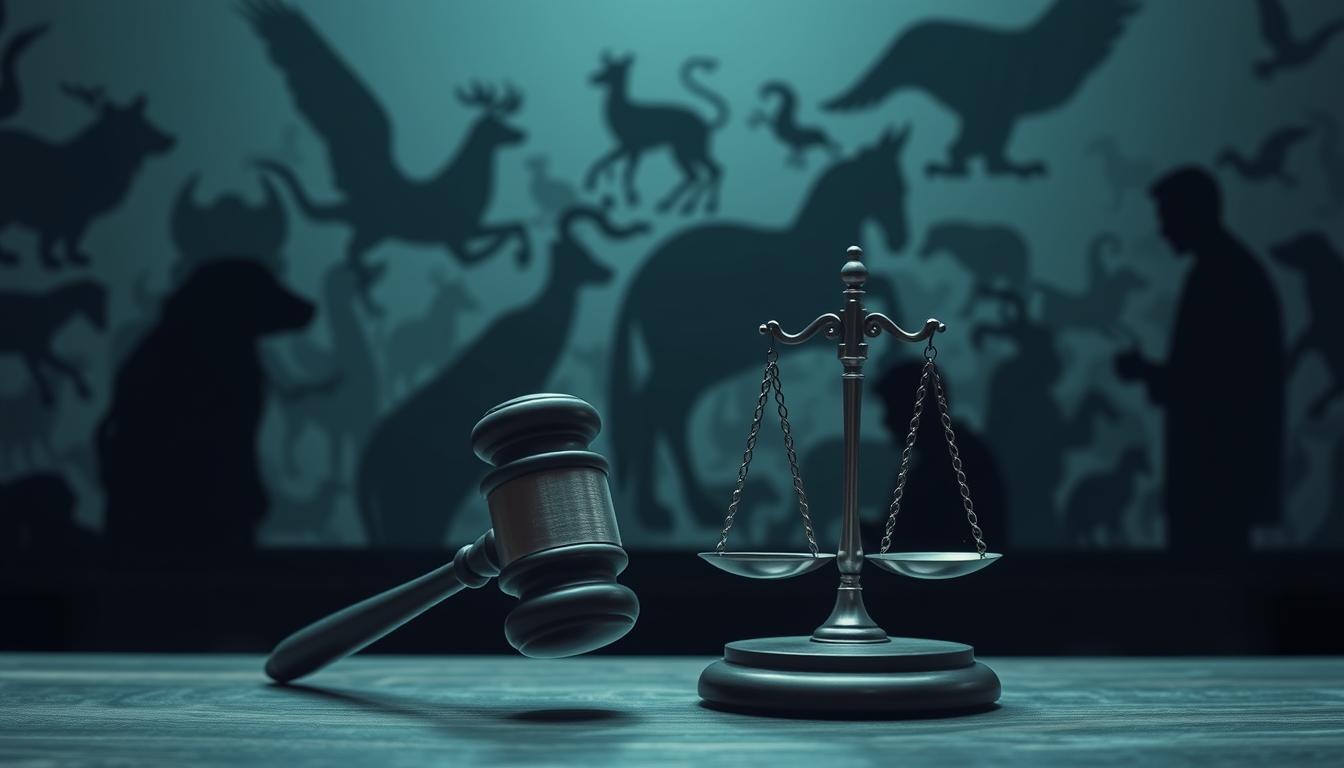The topic of bestiality law stirs strong feelings, ranging from discomfort to outrage. It ties together thoughts on animal rights, morality, and legality in a complex knot. Talking about it prompts a need to dive deep into its legal and ethical sides.
Exploring the maze of bestiality laws reveals how they change, shape views, and show what we value about animal rights and the fight against bestiality. In today’s world, where every word counts, it’s key to notice how laws on bestiality differ place to place. We’ll look closely at bestiality laws’ history, major court cases, and how the push for animal rights is changing things. This brings up big questions about where things are headed12.
Key Takeaways
- Bestiality law encompasses a range of legal complexities that vary by jurisdiction.
- Definitions and prosecutions of bestiality offences often differ between countries.
- Historical developments have shaped the understanding and legal framework of bestiality.
- Animal rights considerations are increasingly influencing bestiality legislation.
- Future reforms may further redefine societal and legal perspectives on bestiality.
Introduction to Bestiality Law
Bestiality law deals with rules against sexual acts with animals. It’s a topic that brings up ethical and legal issues. This area is highly stigmatized and triggers strong feelings, leading to laws against it. Understanding introduction to bestiality law involves looking at how history views these acts.
How these laws are applied differs greatly from place to place. For example, in 2023, New Mexico made big changes to close loopholes in sexual assault of animals laws3. Also, last year, Connecticut made it easier to prosecute bestiality cases3. However, West Virginia still doesn’t have clear laws against bestiality3.
Over time, rules about how animals should be treated have evolved. The ancient Code of Hammurabi had 282 rules about animals. The Hittite laws had around 200 rules, some even addressing bestiality4. Also, the bible in Leviticus says these acts are wrong4.
Now, people also talk about how bestiality affects public health and animal rights. These discussions shape laws, reflecting that most people don’t agree with it. Analyzing legal considerations of bestiality shows this issue from both old and new views.
| State | Bestiality Laws | Recent Changes |
|---|---|---|
| New Mexico | Closed legal loopholes | 2023 |
| Connecticut | Enhanced prosecution | 2022 |
| West Virginia | No explicit laws | N/A |
How we talk about bestiality will shape its laws in the future. Lawmakers and people must keep looking at this topic closely.
Defining Bestiality: Legal Perspectives
Bestiality laws differ a lot around the world. It’s always a crime, but what counts as bestiality can vary. In the U.S., only Hawaii, New Mexico, West Virginia, and Wyoming don’t directly ban it5. Hawaii wants to make it a serious crime, with up to five years in jail and a $10,000 fine5.
Understanding the Legal Definition in Different Jurisdictions
In Canada, to prove bestiality, there has to be penetration, by the person or animal6. There’s talk about making the laws clearer. But changing them has been hard6.
Comparison of Definitions in Canada and the United States
In Canada versus the U.S., the views on animal welfare heavily influence bestiality laws. Canada’s top court wants clearer laws to better protect animals6. But, in places like Wyoming, bestiality might just lead to a year in jail and a fine. This shows how rules vary5.

The Historical Development of Bestiality Laws
The history of bestiality laws is both complex and fascinating. Ancient civilizations like Babylon, under King Hammurabi, had strict rules. If someone was caught engaging in bestiality, both the person and the animal faced death7. This was also true in ancient Egypt, where specific relations between humans and animals were documented7. Over time, the way we view animals and morality has changed, affecting these laws.
In the medieval period, Europe’s approach was harsh. Sweden documented over a thousand executions for bestiality in the 17th and 18th centuries8. These extreme punishments showed how society saw bestiality as a major moral wrongdoing. Laws were heavily influenced by religious and cultural views, seeing animals more as property than beings with feelings.
As time went on, views on animals began to change. By the time of the French Revolution, laws started to reflect these new attitudes8. Despite these changes, bestiality is still illegal in many places today. This shows the ongoing debates about how we should treat animals and their rights.
Interestingly, up to 55% of people have engaged in some form of sexual behavior with animals9. This shows that the issue is still relevant beyond cultural and legal shifts. The way bestiality laws have evolved over time offers insight into changing views on animals and ethics. From strict ancient penalties to today’s laws, this subject continues to spark important discussions.

| Era | Key Developments | Punishments |
|---|---|---|
| Ancient Babylon | Strict laws against bestiality | Death penalty for humans and animals |
| Medieval Europe | Numerous executions documented | Death penalty |
| 17th-18th Century Sweden | Over a thousand executions recorded | Death penalty |
| French Revolution | Legal reforms began to emerge | Variable penalties |
| Modern Times | Bestiality remains illegal | Varies by jurisdiction |
Legal Framework Around Bestiality in the United States
In the U.S., the rules about bestiality vary widely from one state to another. There’s no single federal law that deals with it directly. So, each state decides how to handle these cases on its own, which means the enforcement of these laws can also differ greatly.
Federal vs. State Laws on Bestiality
Federal laws don’t say much about bestiality, but many states have their own rules. In Alaska, it’s seen as animal cruelty, and you could be charged with a Class A misdemeanor10. Arizona goes even further, making it a Class 6 felony. If a minor is involved, the charge jumps to a Class 3 felony10. This shows how different each state’s approach can be.
Key Cases Influencing Bestiality Legislation
Important legal cases have helped shape how laws around bestiality are viewed and enforced. Courts often mirror the public’s changing attitudes toward animals and their welfare. Ancient laws, like those from the Code of Hammurabi, show us that concern for animals is nothing new4. Recent legal actions, such as those in Illinois, have further defined the law by setting clear penalties for harmful acts involving animals10.

| State | Classification of Offense | Penalties |
|---|---|---|
| Alaska | Class A misdemeanor | Cruelty to animals |
| Arizona | Class 6 felony | Escalates to Class 3 felony if involving a minor |
| Colorado | Class 1 misdemeanor | Evaluation required for sentencing |
| Connecticut | Class A misdemeanor | 5-year prohibition from working with animals |
| Hawaii | Misdemeanor (first offense) | Class C felony for subsequent offenses; treatment programs required |
| Idaho | Felony | Up to five years imprisonment, possible custody relinquishment |
| Illinois | Prohibited conduct | Penalties for engaging or permitting sexual contact with an animal |
Analyzing Bestiality Cases: Judicial Precedents
Studying key bestiality cases helps us understand legal views on animal welfare. In Canada and the U.S., cases like R. v. D.L.W. and State v. Newcomb show various interpretations of laws affecting animals’ rights.
Case Study: R. v. D.L.W. in Canada
The Canadian Supreme Court gave a mixed ruling on R. v. D.L.W. Six judges saw bestiality in a limited way, while Justice Rosalie Abella argued for banning all sexual acts with animals11. This significant case reflected society’s increasing worry for animal welfare and set an important legal standard11. Animal Justice pushed for more protection for animals, influencing the court’s view on the case11.
Case Study: State v. Newcomb in the U.S.
State v. Newcomb dealt with the intricacies of animals as property and bestiality issues. The aim was to show the broader harms of these actions, not just property wrongs. The case sparked debates on viewing animals as sentient beings under the law, hinting at a move to protect them more12. This indicates a possible shift towards seeing animals as beings that deserve protection13.

Social Implications of Bestiality Laws
Bestiality laws deeply influence how communities see animal rights and welfare. These laws shape societal views on bestiality, showing how people’s concerns about morality and animal protection matter to lawmakers. Knowing the stigma linked to bestiality helps, since it impacts those involved in legal issues.
In many places, like India under Section 377 of the Indian Penal Code14, bestiality is illegal. How people see these laws is tied to wider social norms. Research points out that rural men with less education are more likely to engage in bestiality, especially if they work closely with animals14. This indicates that both education and environment influence views on animal sexuality.
Current studies find that about 3-8% of the U.S. pop., mainly single white men aged 45-60, sometimes engage in zoosexuality15. Dogs are the most common partners in these cases, highlighting how society’s views affect personal choices15.
Additionally, there’s a concerning link between childhood abuse and later bestiality14. This connection raises tough ethical questions about support and treatment for those involved. It shows the need for animal welfare laws that go beyond punishment. Such laws should also aim to educate and prevent harmful behaviors.

Animal Rights and Bestiality Legislation
Recent talks on animal rights and bestiality laws focus on complex issues. They look at how laws see animals. The discussion shines a light on the property vs. sentient beings debate. It compares old views of animals as things to new views that see them as feeling beings. These changing views are shaping new laws to protect animals better.
The Concept of Animals as Property vs. Sentient Beings
For a long time, the idea that animals are just property ruled legal debates about bestiality. This old thought argues animals don’t have rights like humans do. But, as more people fight for animal rights, there’s a big effort to change this view. The animal rights bestiality legislation showing up in different places now sees animals as feeling beings who deserve legal protection.
Current Trends in Animal Welfare Legislation
In the U.S., lawmakers are making current animal welfare laws stronger to protect animals, affecting bestiality laws too. Only Hawaii, New Mexico, West Virginia, and Wyoming16 don’t clearly ban bestiality. Plus, many states now see bestiality as a serious crime, whether it’s a misdemeanor or felony. This shift shows how laws are changing to reflect today’s morals16.
This push for better animal rights proves we need these changes. It urges lawmakers to make tougher rules against bestiality and animal cruelty. This marks a move towards more kindness and respect for animals4.

Legal Consequences of Bestiality Offenses
Bestiality offenses come with heavy penalties that can change a person’s life. Depending on where it happened, the consequences vary. In Florida, for example, being convicted of bestiality can result in a prison sentence up to five years and a fine up to $5,00017. In other places, the punishment can be as severe as 14 years for the act of sexually penetrating an animal18.

Understanding Charges and Potential Penalties
Bestiality charges affect individuals differently based on the offense’s severity and any past offenses. Since Florida made bestiality illegal in 2011, the penalties have gotten stricter by 2022. Those found guilty may also face a five-year prohibition from owning or working with animals, adding to the impact on their lives17. Federal laws treat bestiality as a broad issue, covering any related acts, which forms an extensive legal boundary around the offense17.
The Role of Criminal Defense in Bestiality Cases
Defending against bestiality charges is complicated but crucial. Defendants work on strategies to lessen the legal fallout and possibly lower the penalties they face. Having a lawyer is important as they help navigate through the law. This is crucial as the court might increase penalties for those with earlier convictions, including counseling and sex offender registration17. Understanding the legal details is key to effectively contesting these grave accusations.
Exploring the Defenses Available in Bestiality Cases
In the realm of bestiality law, different defenses are often used. These can be specific, focusing on certain parts of the charge. Or they can be general, looking at the defendant’s mental state or case circumstances. Understanding these defenses helps see how people legally deal with these serious charges.
Specific Defenses: Mistake and Consent Issues
Consent is a big deal in bestiality legal defenses. A defendant might say there was a mistake in understanding consent. They might believe the animal’s actions showed it was okay. This brings up the tough question of what counts as consent from an animal. Also, proving no penetration can be a defense, especially where the law says bestiality involves this act.
General Defenses: Duress, Insanity, and Intoxication
General defenses are crucial in bestiality cases too. They include claims of duress, insanity, or being drunk or high. Someone might say they did it because they were afraid of getting hurt by someone else. Or they could say they didn’t know it was wrong due to a mental health issue. Being under the influence can also be a defense, saying it messed up their judgment. These defenses aim to make the jury doubt the prosecutor’s story.

| Defense Type | Description |
|---|---|
| Consent Issues | Arguing the absence of clear consent from the animal involved. |
| Mistake | Claims of misunderstanding the circumstances surrounding consent. |
| Duress | Defendant claims coercion or threats resulted in their actions. |
| Insanity | Defendant’s mental incapacity to understand the act’s nature. |
| Intoxication | Impaired judgment due to substance use impacting decision-making. |
The landscape of bestiality case defenses is complex. It shows the various ways defendants try to tackle the charges against them, especially with the ongoing debate around consent and society’s view of these acts1491.
The Role of Public Perception in Bestiality Law
How people see bestiality hugely shapes its laws. Community views drive changes in law and court actions when dealing with this crime. The stigma around bestiality raises society’s anger. This can change jury decisions and how the public talks about it. As opinions shift, laws may also change to reflect new attitudes towards this complex problem.
Examining Stigmatization and its Effects on Legal Practices
Looking back, public views on bestiality have greatly affected legal outcomes. Before 1533, local courts and churches dealt with bestiality in varied ways, often showing mercy19. This history shows the deep social stigma against bestiality, seen as a big wrong. Mostly, single young men were blamed, making the stigma worse19.
Over time, punishments have swung from mild to harsh, driven by public feelings and moral shocks19. Today’s laws show mixed feelings from the public. In forensic psychiatry, responses differ, showing both acceptance and rejection20.
Legal definitions, from “unnatural sexual practice” to “detestable crime,” show the public’s moral shock. These words make bestiality widely condemned, shaping its legal and public image20. This tension not only impacts the accused’s rights but also the defense strategies of lawyers handling such cases.
As people’s views change, its impact on legal practices grows. Society’s opinions and legal outcomes are closely linked, often leaning towards tough actions. Fair representation is crucial for justice in a system swayed by what people think.

| Factors Affecting Public Perception | Impact on Legal Practices |
|---|---|
| Societal Outrage | Leads to harsher penalties and increased prosecutions |
| Historical Context | Affects consistency in how laws are enforced |
| Media Coverage | Shapes public sentiment and influences jury biases |
| Religious Influence | Contributes to framing bestiality as a moral failing |
| Legal Definitions | Reflect societal norms and expectations, creating disparity |
The Future of Bestiality Legislation
As society’s focus on animal rights and ethics grows, so does the talk about laws against bestiality. More people are speaking up, leading to discussions on updating these laws. This shift in conversation aims to better protect animals and tackle related issues more effectively.
Emerging Trends and Potential Law Reforms
There’s a move toward tougher penalties and clearer laws against bestiality. For example, in Maryland, it’s called “unnatural or perverted sexual practice,” and in North Carolina, it’s a “crime against nature.” These differences show how states vary in treating this issue21. This focus on animal protection is shaping new trends in the law. It could lead to a kinder legal approach against bestiality in the future.
Studies show that 31.6% of those involved in animal sex crimes have also committed sexual offenses against people22. This link between animal abuse and violence against humans highlights the need for stronger laws. These laws shouldn’t just punish such acts but also tackle the deeper issues these offenders face22.
Experts argue that scientific and mental health knowledge should influence new laws. They believe understanding the mental side of zoophilia is key to creating better legal solutions23. Updating bestiality laws will show how society’s views are changing. It underscores the gearing towards animal well-being and the complexities of these crimes.

Conclusion
The discussion around bestiality law is complex and needs careful thought. It looks at how laws on this issue have changed, showing why it’s essential to keep talking about it. These conversations shape how people think and act towards laws on animal rights.
History and past legal cases show how people’s views influence laws. Bestiality brings out strong feelings. This makes it crucial to think about morals and how we see animal rights today. The current legal setup shows we must keep researching and fighting for better treatment of animals and higher moral standards.
Ending the debate on bestiality laws calls for understanding and compassion. As we progress, pushing for better laws on this topic is vital. Open talks help everyone work together for laws that care for both humans and animals. This way, we aim for a future that’s fair for all2425.










